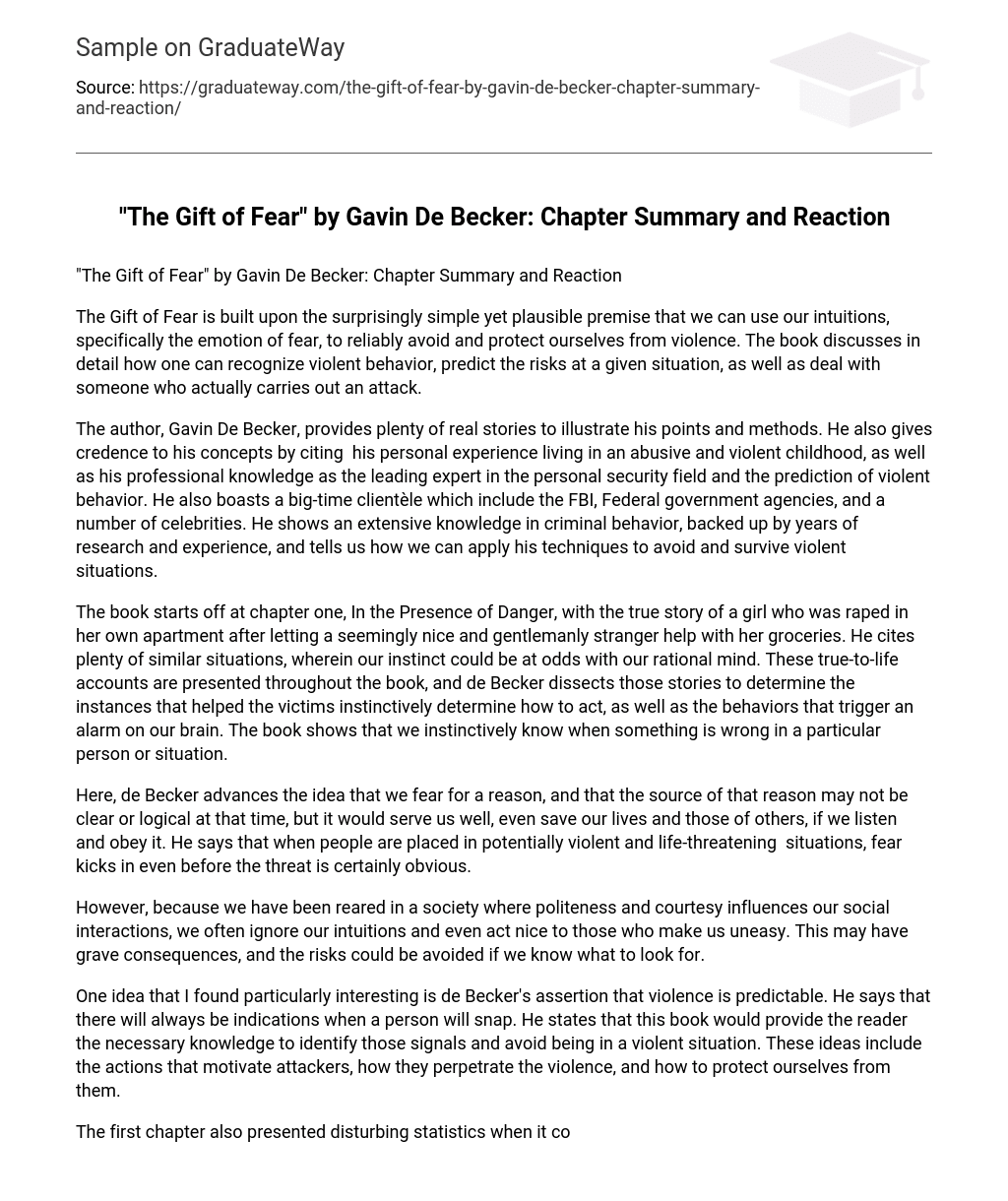The Gift of Fear is built upon the surprisingly simple yet plausible premise that we can use our intuitions, specifically the emotion of fear, to reliably avoid and protect ourselves from violence. The book discusses in detail how one can recognize violent behavior, predict the risks at a given situation, as well as deal with someone who actually carries out an attack.
The author, Gavin De Becker, provides plenty of real stories to illustrate his points and methods. He also gives credence to his concepts by citing his personal experience living in an abusive and violent childhood, as well as his professional knowledge as the leading expert in the personal security field and the prediction of violent behavior. He also boasts a big-time clientèle which include the FBI, Federal government agencies, and a number of celebrities. He shows an extensive knowledge in criminal behavior, backed up by years of research and experience, and tells us how we can apply his techniques to avoid and survive violent situations.
The book starts off at chapter one, In the Presence of Danger, with the true story of a girl who was raped in her own apartment after letting a seemingly nice and gentlemanly stranger help with her groceries. He cites plenty of similar situations, wherein our instinct could be at odds with our rational mind. These true-to-life accounts are presented throughout the book, and de Becker dissects those stories to determine the instances that helped the victims instinctively determine how to act, as well as the behaviors that trigger an alarm on our brain. The book shows that we instinctively know when something is wrong in a particular person or situation.
Here, de Becker advances the idea that we fear for a reason, and that the source of that reason may not be clear or logical at that time, but it would serve us well, even save our lives and those of others, if we listen and obey it. He says that when people are placed in potentially violent and life-threatening situations, fear kicks in even before the threat is certainly obvious.
However, because we have been reared in a society where politeness and courtesy influences our social interactions, we often ignore our intuitions and even act nice to those who make us uneasy. This may have grave consequences, and the risks could be avoided if we know what to look for.
One idea that I found particularly interesting is de Becker’s assertion that violence is predictable. He says that there will always be indications when a person will snap. He states that this book would provide the reader the necessary knowledge to identify those signals and avoid being in a violent situation. These ideas include the actions that motivate attackers, how they perpetrate the violence, and how to protect ourselves from them.
The first chapter also presented disturbing statistics when it comes to violence, particularly in America. Oftentimes we think that crime and violence is something that occurs elsewhere. We are shocked when a hundred people are killed in a plane crash, when in most crimes, the guilty ones are the very people whom the victims know or are close to. The statistics was also presented to stress that everyone, especially women, are at risk. De Becker tells us to dispel any notions of invincibility because the dangers are real and that violence could happen to anyone. I found this chapter very enlightening, as it sets the tone and the general approach of the whole book.
In the book’s second chapter, The Technology of Intuition, De Becker shows that instances when we usually think that our perception is extraordinary or supernatural may not be that mysterious at all. He states that it is but something that is guided by the sound and reasonable workings of our brain, if seemingly unconscious.
In a society where logic is given more weight than emotion, we oftentimes disregard and distrust our fears and intuition until it’s too late. We denigrate our instinct, looking down on them as mere trivialities, so we try rationalize things even though our brains are telling us that something, though inexplicable, is certainly wrong. De Becker also points out in that hindsight, most victims of violence would recall certain signals and indicators that could have clued them in on the impending danger, had they not ignored what their instinct tells them. Here, I realized that fear is something that has to be embraced and accepted, rather than clobbered down.
He also tackles the issue of denial, a way thinking that gets in the way of making an appropriate response to a situation. There are also “kangaroo signals” wherein conventional wisdom gets in the way of a reliable assessment of the situation.
This book should help a person break out from such denials and understand the things that distract us from our intuition. If these skills were fine-tuned, we could significantly lessen the risk of violence.
On a greater scale, this book is a must for anyone living in well-populated or urban cities. It provides both the strength and knowledge to stand up to attacks. I found it very helpful and insightful, as de Becker writes in a clear and convincing language.
The Gift of Fear has made a significant impact to my life, and made me a little less uneasy in my day-to-day activities. Which is not to say that one must be over-confident. It helped me discern what I should be wary of or alerted to instead of suspecting that everyone has evil designs.
Reading this book did not make me more paranoid about the evils of the world as I initially expected, it actually made me empowered knowing that I have the strength and understanding to deal with any potentially violent or fatal situation.





